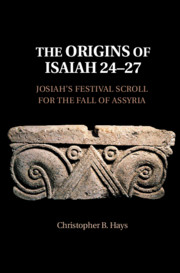Book contents
- The Origins of Isaiah 24–27
- The Origins of Isaiah 24–27
- Copyright page
- Dedication
- Epigraph
- Contents
- Acknowledgments
- Abbreviations
- Introduction
- 1 The Rhetoric of Chaos
- 2 The Royal and Divine Victory Banquet
- 3 Revivification of the Dead as National Deliverance
- 4 The Lofty City and the Army of the Height
- 5 Josiah and the Remains of Israel
- 6 The Language of Isaiah 24–27 in Light of Hebrew Diachrony
- 7 Stirring the Echoes
- Conclusion
- Book part
- Bibliography
- Index of Modern Authors
- Subject Index
- Ancient Text
3 - Revivification of the Dead as National Deliverance
Published online by Cambridge University Press: 11 June 2019
- The Origins of Isaiah 24–27
- The Origins of Isaiah 24–27
- Copyright page
- Dedication
- Epigraph
- Contents
- Acknowledgments
- Abbreviations
- Introduction
- 1 The Rhetoric of Chaos
- 2 The Royal and Divine Victory Banquet
- 3 Revivification of the Dead as National Deliverance
- 4 The Lofty City and the Army of the Height
- 5 Josiah and the Remains of Israel
- 6 The Language of Isaiah 24–27 in Light of Hebrew Diachrony
- 7 Stirring the Echoes
- Conclusion
- Book part
- Bibliography
- Index of Modern Authors
- Subject Index
- Ancient Text
Summary
Images of revivification are attested widely and deeply in ancient Near Eastern history, and such images are often used for political restoration. In the Amarna Letters, and in Hittite and Neo-Assyrian letters, vassals who have been saved by the emperor regularly write and describe themselves as dead men who have been brought back to life; the same enduring motif is also found in the Cyrus Cylinder. This royal role was in some way a reflection of divine life-giving, as many deities, from Marduk to Baal, were said to raise the dead. One of the standard roles of the king and gods in the ancient Near East was as a giver or restorer of life.
Therefore, biblical passages that deploy the same images offer no inherent grounds for late dating. Revivification imagery is not, in other words, a basis on which to date a passage to a late period. The passages describing Yhwh’s power over death in Isa 25:7-8 and 26:19 lack the literary cohesiveness and detail found in Ezek 37:1–14, as well as the references to sectarian differences and eternal fates found in Dan 12. The less developed Isaiah passages should be considered earlier.
- Type
- Chapter
- Information
- The Origins of Isaiah 24–27Josiah's Festival Scroll for the Fall of Assyria, pp. 68 - 94Publisher: Cambridge University PressPrint publication year: 2019



